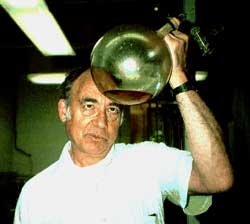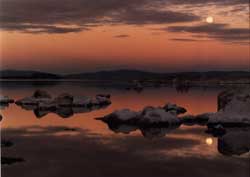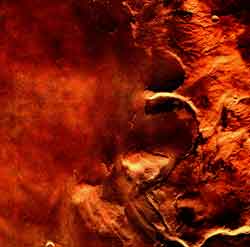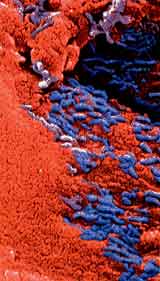

| |
Superbugs
From Hell
 |
 |
 |
 |
New evidence suggests that life on Earth began not in shallow pools on
the surface, but in the torrid depths of the planetary crust. And the
planet in question might not even be the Earth...
by Paul Davies
For centuries, people thought life was created in the Garden of Eden by
God. Then along came Charles Darwin with his theory of evolution, and
spoilt that cosy image. Darwin gave a convincing account of how all life
on Earth has gradually evolved from simple microbes. However, he left open
the question of how life got started in the first place. Now scientists
are sure they are close to solving that mystery too, and the answer looks
set to inflame passions once again.
Chemists have long tried to make life in a test tube, by simulating the
conditions of the primeval Earth. Envisaging an ancient pond laced with
minerals and bathed in solar radiation, researchers pinned their hopes on
finding a chain of reactions that would transform a lifeless chemical soup
into a primitive organism.
 |

American
chemist Stanley Miller surveys the contents of a flask where
primitive gases have been zapped by an electric spark. For many
years, scientists assumed this was how life started on Earth: now,
many have doubts. |
 |
photo
- Hencoup Enterprises |
 |
Chicago chemist Stanley Miller blazed the trail in the early 1950s by
zapping a noxious brew of gas and water with electricity. Others have
tried different formulae. Unfortunately, after fifty years of
experimentation, the results are disappointing. Some of the simpler
building blocks of life, like amino acids, are readily made, but the
building itself - a living cell - remains as elusive as ever.
Deep-sea Life
Now a radical new theory could explain the lack of progress. Scientists
increasingly suspect that the tepid pool scenario is wrong, and that life
didn't start on the Earth's surface at all. This change of mind stems from
the startling discovery of bizarre micro-organisms, dubbed superbugs or
extremophiles, that inhabit some of our planet's most extreme
environments.
In the late 1970s, a research submarine called Alvin was sent to the
bottom of the Pacific Ocean to explore a string of volcanic vents known as
'black smokers'. These chimneys on the sea floor spew forth superheated
water rich in dusky chemicals. The investigators were astonished to find
many exotic life forms clustered around the searing effluent in pitch
darkness, including weird-looking crabs and giant tube worms.
Most remarkable of all were bacteria that inhabited the hot zone
itself, thriving in the disgorging fluids at temperatures in excess of 100oC.
Previously, nobody believed that any life could survive above the normal
boiling point of water. These superbugs lie at the base of the food chain.
They are primary producers, turning inorganic material from the hot vents
directly into biomass, without the need for sunlight.
Subterranean Bugs
Alvin's discovery turned out to be just the tip of the iceberg. In the
1980s, Thomas Gold, an astrophysicist from Cornell University, New York,
supervised an oil drilling project in Sweden. On examining the rock cores
from several miles down, Gold was amazed to find unmistakable signs of
life.
At the time, the idea that something could live so deep in the Earth's
crust was laughed at. There have been many stories about life in the
underworld, from the Greek fable of Orpheus to Jules Verne's Journey to
the Centre of the Earth. Few scientists took the possibility
seriously. But Gold's claim was confirmed when other drilling projects
yielded similar results. Biologists in the United States began extracting
live microbes from miles beneath North Carolina and the Columbia River
basin. Environmentalists became concerned that subterranean superbugs
might eat through containment vessels of buried nuclear waste, causing
leaks.
Meanwhile, the international Ocean Drilling Programme retrieved rocks
from far below the seabed, and the story was the same. The basalt of the
ocean floor is teeming with microbes too. Some of them have been cultured
in the laboratory by John Parkes of the University of Bristol, who
believes that some species can withstand temperatures as high as 169oC.
It is beginning to look as if there may be as much biomass inside the
Earth as there is on the surface.
Our Ancestors?
The full significance of the deep-living microbes became clear only
after their innards were analysed, following the pioneering work of Karl
Stetter at the University of Regensburg in Germany. By sequencing the
superbug's genes, microbiologists can construct a sort of family tree
linking them with normal bacteria. The results came as a complete
surprise. It turns out that the oldest and deepest branches of the tree of
life are all occupied by heat-loving superbugs. In other words, the
microbes residing deep within the Earth are among the world's oldest
surviving organisms. In effect, they are living fossils, having changed
little since the dawn of time.
 |

Mono Lake in
California is thick with salt and - in places - almost boiling.
Yet it thrives with microbes, closely related to the earliest
life-forms on Earth.
|
 |
 |
photo
- Jerre Goldin |
 |
To some researchers these discoveries spell out a fascinating message. It
suggests that life was incubated in the volcanic depths of the Earth, in
pressure-cooker conditions, and migrated to the cooler surface zone only
much later. This theory neatly meshes with what we know about the Earth's
history. The Solar System is four and a half billion years old. For almost
a billion years after the planets formed they were pounded mercilessly by
giant asteroids and comets. A record of this primordial violence is etched
on the face of our nearest neighbour in space - the Moon - which is
pockmarked with countless large craters.
The biggest impacts would have blasted away the Earth's atmosphere and
swathed the globe in incandescent rock vapour. The heat pulses were fierce
enough to boil the oceans dry and sterilise the exposed land to a depth of
half a mile or more. Not even superbugs could survive such cataclysmic
episodes unprotected. Yet, paradoxically, there are traces of relatively
advanced life in ancient rocks from Greenland dated at over 3.85 billion
years - a time before this massive cosmic bombardment had abated. But if
the 'comfort zone' of heat-loving microbes was deep enough, they could
shelter from the cosmic barrage in the torrid strata of the Earth's crust,
beyond the reach of even the fiercest heat pulses.
Superbugs on Mars
 |

Mars today is a
frozen desert « yet dried-up channels and crater erosion hints
that the Red Planet was once warmer and drier, with rivers and
possibly oceans. Was this, too, a cradle of life? |
 |
 |
photo
- NASA |
 |
If the theory is right, and life did begin deep within the Earth, it may
also have got going beneath the surfaces of other planets too. Mars is an
obvious candidate. When two Viking space probes landed there in 1977 they
scooped up some dirt to test for biological activity. No clear evidence
was found, and most scientists pronounced the Red Planet dead. With
hindsight, this outcome wasn't surprising, since the surface of Mars is a
freeze-dried desert bathed in ultra-violet radiation that would prove
lethal to almost all known organisms. However, beneath the hostile
surface, conditions may be more congenial for life. Geothermal heat will
have melted the permafrost to create reservoirs of liquid brine similar to
those beneath the Earth's sea bed. So there might be superbugs lurking
below the harsh Martian terrain.
Although today Mars is cold and dry, in the remote past it was warm and
wet, and not unlike Earth. It had rivers and glaciers and possibly a large
ocean. Life may well have spread to the planet's surface and briefly
flourished in the Martian spring, before the atmosphere leaked away and
the temperature plunged. It's possible these ancient organisms left
fossils in the surface rocks, where they may be discovered by forthcoming
missions to the Red Planet.
 |

The infamous
"microbes from Mars". Magnified 100,000 times the
interior of a meteorite from Mars (coloured red) reveals
intriguing bug-like shapes (blue). Researchers are stilling
arguing whether these are indeed fossilised bacteria. |
 |
 |
photo
- NASA |
 |
A few years ago, some scientists claimed to find fossilised microbes
within a Martian meteorite collected in Antarctica. Although the jury is
still out on that, it no longer seems so fanciful to speculate that Mars
has, or at least once had, some form of life.
If there is, or was, life on Mars, then it raises a fascinating
possibility. Back in the early history of the Solar System, the heavy
bombardment that made conditions on the planets so dangerous for surface
life would also have kicked vast numbers of rocks out into space. Many
Mars rocks must have reached Earth during our planet's history, and many
ejected Earth rocks will have hit Mars. Could hardy superbugs dwelling
within these rocks have hitched a ride through space and taken up
residence on arrival?
Current evidence strongly suggests the answer is yes, and that Earth
and Mars cross-contaminated each other billions of years ago. It's even
conceivable that life began on Mars and travelled to Earth some time later
in meteorites, colonising our planet when conditions eventually became
favourable. If so, we are all descended from Martians!
The Garden of Eden - Revisited
Tantalising though these developments are, the problem remains of how
the first living cell formed. What chemical magic triggered the vital
spark? Whether the key process happened on Mars, Earth, or both, the
puzzle of the chemical genesis of life is still unsolved. Armed with the
new ideas, however, researchers are now focusing their efforts on the
chemistry of hot rocks infused with sea water. Might the gases exuded by a
planet's crust offer a more potent mix than those of the primordial
atmosphere? Could the pores in ocean basalt play the role of tiny
crucibles, in one of which was forged that microbial Adam long, long ago?
Some scientists think so, and are increasingly hopeful that the key steps
will soon be understood.
In many cultures the underworld has long been associated with the realm
of the dead. For Christians, it is the traditional location of Hell, a
place of fire and brimstone, and eternal torment. How ironical if the
torrid, sulphurous depths actually harboured the cradle of life. Far from
being Hell, the broiling bosom of our planet might well turn out to have
been the true Garden of Eden.
Professor Paul Davies is a leading physicist with an
international reputation for explaining scientific ideas in simple
language. Born in London, but now based in South Australia, he has held
academic positions at Cambridge, London, Newcastle upon Tyne, Adelaide and
Queensland Universities. Davies's interests include the nature of time,
high-energy particle physics, the foundations of quantum mechanics, the
origin of life and the nature of consciousness. His books include The
Cosmic Blueprint, The Mind of God, The Last Three Minutes, About Time and
The Fifth Miracle, which examines the origin of life and the
possibility of life on Mars.
|
|
